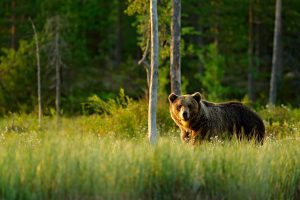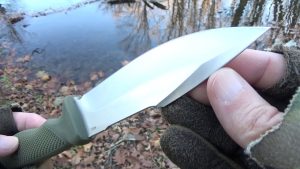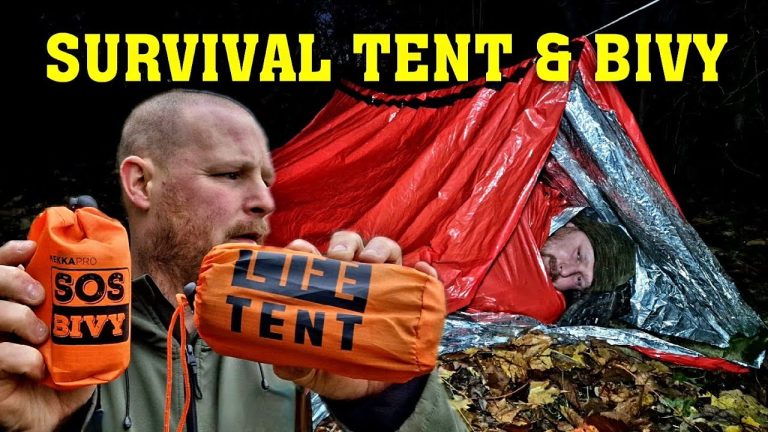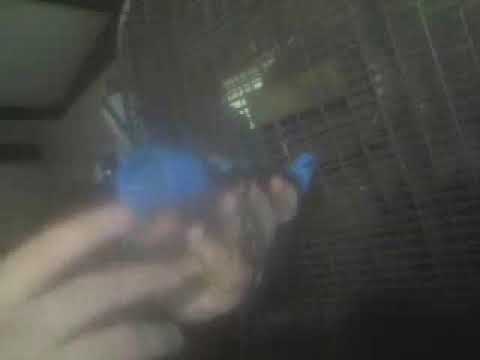(This article was originally published in Prepper Survival Guide)
You might feel at home in the Great Outdoors, and, truly, it’s a wonder to behold. There are, however, dangers as well, such as encounters with large wild animals. It pays to know what to do when you encounter them on or off the grid.
At our mountain home in Gatlinburg, Tennessee, the area’s iconic mascot, the black bear, is a common sight. So common, in fact, that our yard is part of their daily circuit.
Bears are mammals belonging to the family Ursidae, and I’ll bet you don’t know what their closest living relative is: Dogs? Nope, it’s seals. There are a number of bear species in North America, but the American black bear is the one that’s present just about anywhere in the U.S. About 2000 live in the Great Smoky Mountains area; many of them have, unfortunately, become very accustomed to humans.
 Large black bear male as seen from our deck
Large black bear male as seen from our deck
Black and brown/grizzly bears eat more plant matter than meat, opportunistically taking in any food source they can find. Poor crops of staple foods like acorns, called “mast,” result in bears moving out of the back country to look for less than natural alternatives, like your campsite or suburban trash.
Even though black bears are only 8 ounces when they’re born, males (also known as boars) can weigh 400 pounds. Grizzly newborns weigh a pound, but boars may reach 650-700 pounds in their prime. In Alaska, male brown bears commonly reach 1000 pounds!
(Note: The great chestnut blight of 100 years ago took out almost all the chestnut trees in the Great Smokies, resulting in smaller-sized black bears in modern times.)
Black bears vs Grizzlys
In the eastern part of the United States, there are only black bears. In the American and Canadian West, brown or grizzly bears are also encountered. ”Grizzly,” refers to white-tipped hair on the back and shoulders of some brown bears. While their diet, habitat, and many behaviors are similar, there are ways to tell the difference between them:
- Despite the names brown/grizzly and black, color isn’t always one of them. For instance, grizzlies may range from blonde to almost black. From a distance, a grizzly bear may appear to have darker legs and lighter upper parts. Black bears are usually uniformly black, but not always: They can be brown, cinnamon, or patchy.
- Body size is also not a reliable indicator for identifying bears in the West. A typical adult female grizzly weighs 300-400 pounds and adult males weigh 300-650 pounds. An adult black bear may not only weigh the same as a female grizzly but also be about the same height (3–4 feet at the shoulder).
- Grizzly bears have a prominent shoulder hump between the front shoulders. This is most visible from the side. Black bears have no such hump.
- A grizzly typically has a concave face that extends from between its “brow” to the end of its nose. A black bear normally has an almost straight profile from forehead to nose.
- Grizzly bears have smaller, more rounded ears in proportion to their head size. Black bears have larger ears that are more pointed and erect.
- Grizzly bears have curved, often light-colored claws that can be longer than a person’s finger. Black bears have darker claws that are usually less than two inches long.
- The tracks of a grizzly’s front feet are squarer than that of a black bear. A black bear front track is more rounded.
Bear Encounters
The National Park Service says that each bear encounter is unique; there is no single strategy that will work in all situations. To prevent injuries from bear encounters, situational awareness is the order of the day. Be especially careful in areas where bears are active. In national parks, signs are placed at trailheads where bear encounters have recently been documented. Watch for disturbed trash, fresh tracks, droppings, and of course, actual bears.
Some basic advice: Don’t hike alone. Whenever possible, you should hike in groups, 90% of people injured by bears (mostly grizzlies) in Yellowstone National Park were alone or with only one other hiking partner.
You might think it’s not smart to yell “Any bears out there?” or sing “The Star-Spangled Banner” on the trail, but bears don’t like noise and it’s actually a pretty good strategy. This is especially appropriate when traveling near babbling brooks or other settings where normal hiking noises might be muffled (just don’t do it with a hamburger or hot dog in your hand).
When you see a bear, it will, hopefully, be at a distance: If so, and the bear doesn’t see you, keep out of sight and go slowly behind and downwind of it. If the bear does see you from far away, slowly retreat.
Accidental Encounters
 You might encounter a bear in the backcountry
You might encounter a bear in the backcountry
You’re just as likely to come upon a bear as it is to come upon you. Avoid hiking at dawn, dusk, or at night. These are times that bears are most active in warm weather months.
Bears, like humans, have a need for personal space. If you happen upon a bear, don’t approach it, even to get a photo; give it as much room as possible. This advice is often ignored by foolhardy tourists at their peril.
If your encounter with the bear on the trail is up close and personal, or if it wanders into your campsite, identify yourself as a human by speaking calmly in a monotone voice.
Try to look as large as possible. If in a group, stay close together. Pick up small children immediately.
Back away slowly in the opposite direction. Walk, don’t run. Running triggers a chase response in the animal. Keep your eye on the bear so you can see how it will react, but avoid direct eye contact (considered an act of aggression). In most cases, the bear will move on.
Advice on how to deal with bear encounters is not universal: The National Park Service (NPS) recommends moving away sideways, reasoning that you are less likely to trip than walking backwards. This is certainly true, but there’s not much room to move sideways if you’re on a trail. Although the NPS says to avoid eye contact and not shout, other sites actually recommend direct eye contact and loud noises, in the hopes that it will intimidate the bear.
One piece of advice that’s universal: If you have a backpack, keep it on. It might provide protection if you’re attacked. If you’re camping, be sure to store your food up high and well out of reach.
A Bear In Your Backyard
From personal experience, we can tell you that bears are becoming less wary of wandering into human-occupied areas to find food. If you encounter a bear in your backyard:
- From a safe distance, shout or bang pots and pans together.
- Check your yard for bears before letting out your dog. A dog is unlikely to win a confrontation with one.
- Leave the bear a clear escape route (do not corner it).
- Remove potential attractants such as garbage or pet food; ask neighbors to do the same.
- If, for some reason, a bear enters a building, leave the doors open as opposed to locking the bear in. More commonly, a bear will enter an unlocked car; yes, they can open car doors. Don’t leave food in the car.
Defensive Encounters
A bear that feels threatened may act defensively if you get too close. It can react in a number of ways, snapping its jaws, huffing, hissing, growling, yawning, or swatting the ground while blowing and snorting. The bear may lunge or “bluff charge” toward you in an attempt to get you to leave the area. This is most commonly seen with a mother protecting cubs.
Once a bear has noticed you and is annoyed by your presence, consider some additional strategies to help prevent the situation from escalating. Some western parks require pepper spray for campers and hikers; know how to use it. Try to de-escalate the situation by talking calmly, so the bear knows you’re a human and not a prey animal. Remain still and stand your ground. As mentioned earlier, running might activate a chase response in the animal. Wave your arms and appear as large as possible.
The bear may stand on its hind legs to get a better look or smell. A standing bear is usually more curious than anything else. Continue to talk to the bear in low tones; this will help you stay calmer, and it won’t be threatening to the bear. A scream or sudden movement may trigger an attack. Never imitate bear sounds or make a high-pitched squeal.
Bear Attacks
 Grizzly bear image by Robert Balog on Pixabay
Grizzly bear image by Robert Balog on Pixabay
Most bears are only interested in protecting their space, getting food, and protecting their young. A bear in predatory mode, however, will act differently than a curious or defensive one. If the bear follows you quietly, head low, ears laid back, with attention clearly directed at you, it is more than just curious. Make yourself appear larger, louder, and threatening. Groups should stick together to look like a bigger threat.
If the bear attacks, don’t run. You can’t outrun a bear. The top speed of a running bear is 35 miles per hour, far surpassing that of the fastest humans.
Unless you’re a squirrel, don’t climb a tree. You’re not 10 years old anymore; it takes longer than you think and your pursuer is a very good climber.
As the bear approaches, stand your ground and have your pepper spray out. Note the wind direction and adjust your position so the spray doesn’t fly back at you. Be sure the safety is off. Aim for the face and start spraying when the bear is within 25-30 feet away. Although it is most effective at 5-10 feet, the initial whiff further away may discourage the attack. If not, continue spraying until the can is empty. Note that there is a tendency for the can to recoil upward, so you must spray downward to hit your target.
Although predatory bear attacks are rare, you should know what to do if physical contact is made. The National Park Service recommends different actions for different species of bear:
Grizzly Bears: With grizzlies, fighting back may intensify the fury of their attack. If you are attacked by a brown/grizzly bear, leave your pack on and play dead. Lay ?at on your stomach with your hands clasped behind your neck and your forearms protecting your face. Spread your legs to make it harder for the bear to turn you over. Remain still until the bear leaves the area. A persistent attack or an attack in your tent may leave you no choice but to fight back. If that’s the case, use whatever you have at hand to hit the bear in the face.
Black Bears: When a black bear physically attacks, the rangers recommend you don’t play dead. Be aggressive and fight back using any object available, concentrating on inflicting trauma to the bear’s face, eyes, and snout.
Assuming you survive the attack, you may have bleeding wounds. Make sure your backpack has dressings, tourniquets, antiseptics, and other supplies needed for treating wounds. This is good advice in any backcountry setting.
Studies have shown that bears accustomed to humans never live as long a life as truly wild bears. Bears lose their fear of people by being fed by them. As a result, many of these are hit by cars or end up euthanized. Remember this: A bear that’s fed is a bear that’s dead.
Joe Alton, MD
Hey, don’t forget to check out our entire line of quality medical kits (including suture kits) at store.doomandbloom.net. Also, our Book Excellence Award-winning 700-page SURVIVAL MEDICINE HANDBOOK: THE ESSENTIAL GUIDE FOR WHEN HELP IS NOT ON THE WAY is now available in black and white on Amazon and in color and color spiral-bound versions at store.doomandbloom.net.










 Black bear droppings
Black bear droppings Dr. Alton
Dr. Alton
 Medical kit by Doom and Bloom/Grab N Go(r)
Medical kit by Doom and Bloom/Grab N Go(r) 











